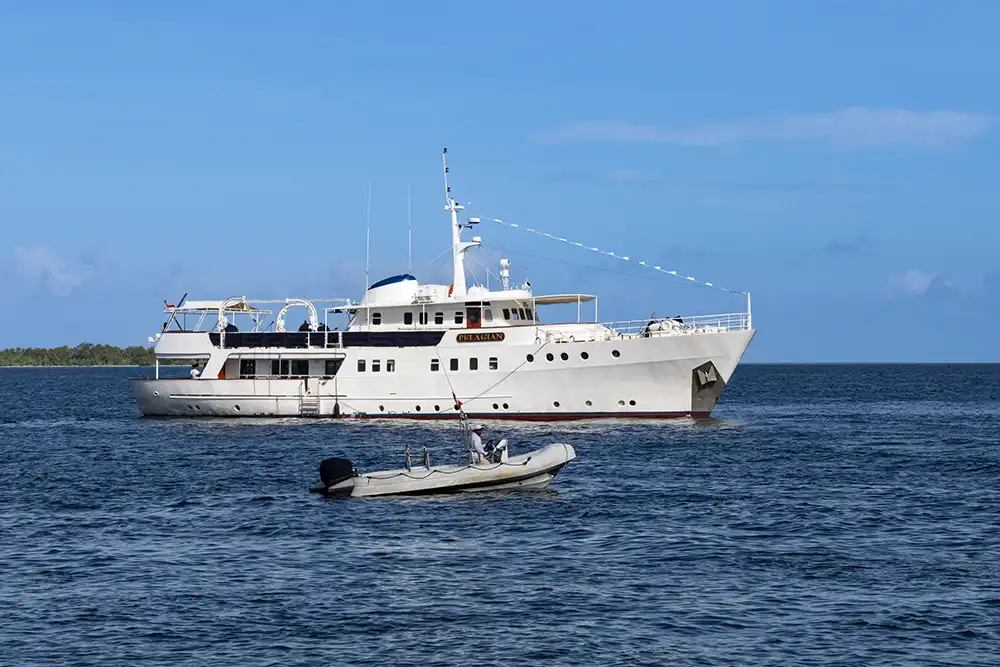

A choice divers often face when planning a luxury dive trip is between an idyllic land-based resort or a liveaboard cruising distant reefs. At Wakatobi Dive Resort, you can have both.
By Walt Stearns
Wakatobi has earned a reputation as one of the world’s premier snorkelling and scuba diving destinations, delivering a combination of pristine reefs, relaxed luxury and five-star service. To complement the land-based operation, Wakatobi also operates an equally lavish live-aboard dive yacht named Pelagian.
The making of a dive yacht
Measuring 35m/115ft in length, with a copious 7.3m/24ft beam, the MV Pelagian is a substantial ocean-capable vessel. Launched from the Batservice Verft A/S Shipyard in Mandal, Norway, she began life as an elegant world-ranging motor yacht named Harmony. Some 14 years later, she was purchased and adapted into a liveaboard dive yacht Fantasea II by Red Sea diving pioneer Howard Rosenstein.
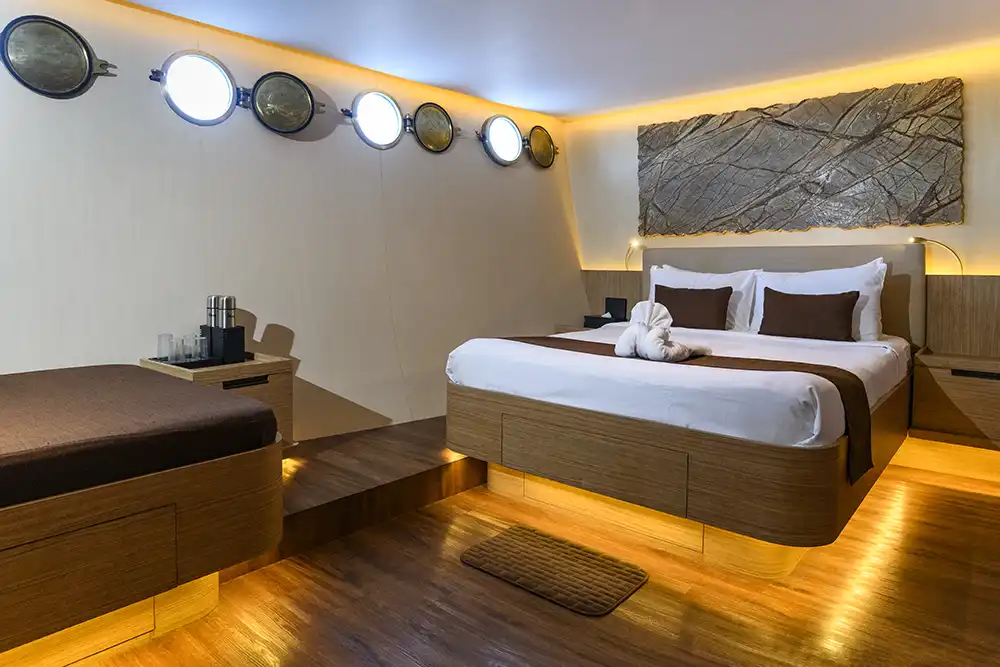
Through the 1980s, Fantasea II was seen by serious divers and undersea explorers such as Dr Eugenie Clark, Stan Waterman and David Doubilet as a premier liveaboard and the ‘grand lady’ of the Red Sea. She was sold and moved to Seychelles in the early 1990s, until returning to Indonesia in 2005 under the name Pelagian.
Wakatobi Dive Resort took over the operation of Pelagian on behalf of her owner, Dive Asia Pacific, before purchasing the liveaboard and giving her a mechanical overhaul and luxury refit in 2008, accompanied by a comprehensive redesign of her floor plan to make her the world-class dive yacht she is today.
Luxury cruising with Pelagian
From the moment you step aboard, it’s apparent that Pelagian is a different breed of dive yacht; one of its most noticeable departures from liveaboard convention the fact that Pelagian is configured – rather like a private luxury yacht – to host a maximum of ten divers in its five spacious cabins.
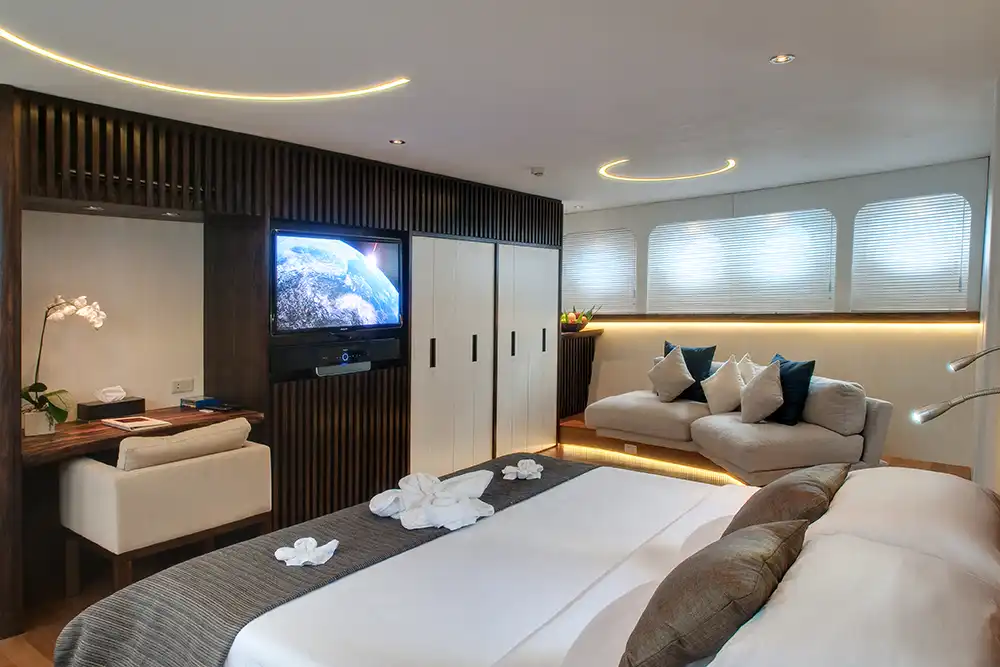
For those seeking the most lavish experience, the master suite spans the full width of the vessel, occupying the entire forward portion of the main deck. Amenities include a walk-around king-size bed, a spacious lounge with a love seat, and an entertainment centre fitted with a huge flat-screen HDTV and Blu-ray DVD player. The contemporary bathroom has a spacious dressing area, top-of-the-line rainforest shower, and vanity fittings.
Also offering an enhanced level of luxury are Pelagian’s two below-deck Superlux Staterooms, which feature a walk-around, queen-size bed, a separate day bed, and an ensuite bathroom and shower. Having stayed in one of these cabins I can attest that they are exceedingly roomy.

The main salon and dining area mirror the upscale décor and furnishings you would expect from a high-end private yacht and its full range of creature comforts.
Additional social areas on the top deck and near the bow are ideal for reading, quiet relaxation in the sea air or spectacular star gazing in the evenings.
Pelagian’s personal touch
Pelagian is staffed by a crew of 12, which includes dedicated stewards and an executive chef who creates fine dining experiences daily, either inside the climate-controlled main salon or out on the spacious aft fantail against a stunning backdrop of sea and sky.
Dive briefings take place on the yacht’s shaded aft decks, after which all you need to do is suit up, as gear transfers between the yacht and its two custom-fabricated dive tenders are handled by the crew.
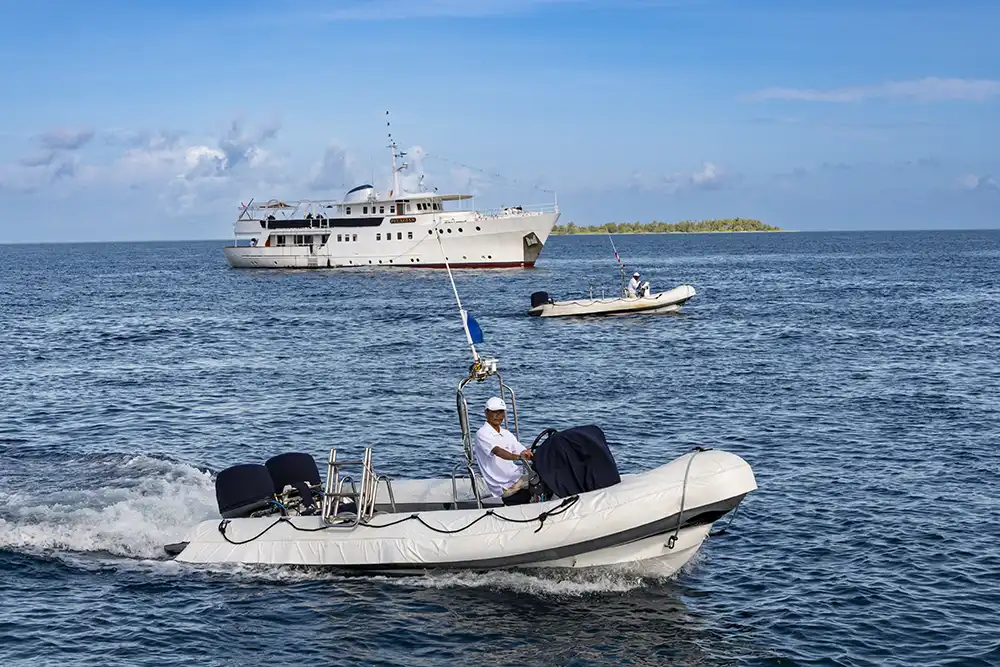
As an added personal touch, the crew rinse your wetsuits and dive skins and hang them to dry on the upper deck between dives. I had to chuckle when we found our wetsuits neatly laid out on the fantail like evening wear, with dive booties just below.
The comfortable dive tenders are 18-foot rigid-hull inflatable boats (RIB) equipped with dual 60-HP outboard engines, tank racks and one of the sturdiest deck-mounted stainless steel boarding ladder systems for divers I have ever seen in a RIB. With a maximum of just ten passengers per cruise, there is plenty of room on the RIBs the divers – and especially those carrying cameras.
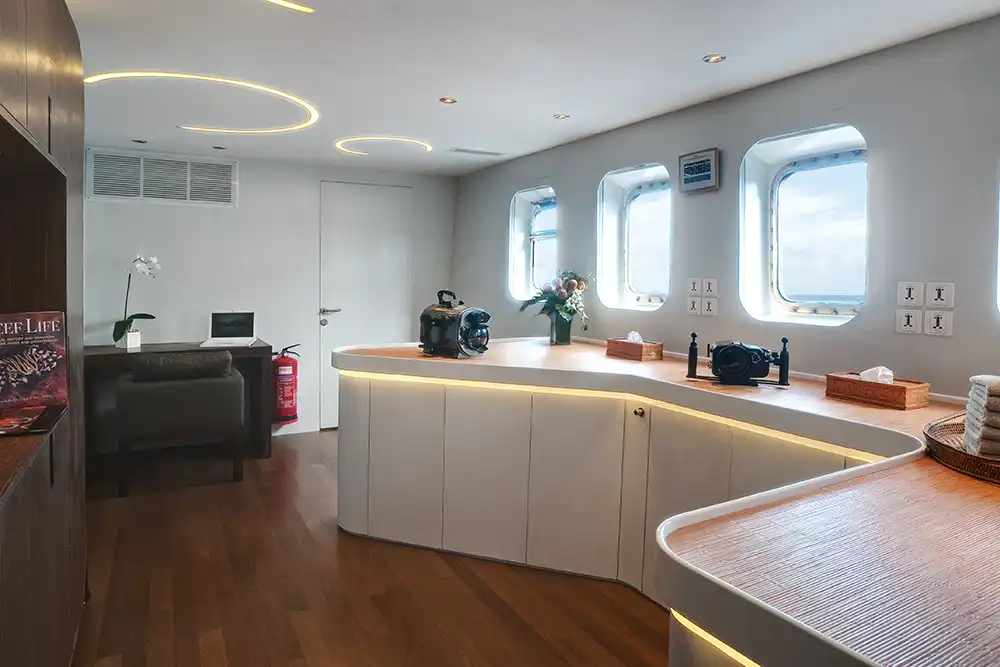
Underwater photographers are well catered for by Pelagian’s dedicated indoor climate-controlled camera room, which has plenty of counter space for a large number of camera systems, together with an ample supply of Indonesia’s standard 2-prong 220v/50Hz electrical outlets and 110-volt adapters and power rails.
Gas mixtures for diving are provided by a trio of Bauer K-14 compressors with a Nitrox Technologies NO2 system. While 32 per cent is the standard nitrox mix, Pelagian can accommodate custom charters with custom nitrox and trimix blends, as well as oxygen fills and sorb for rebreather divers.
Diving from the MV Pelagian
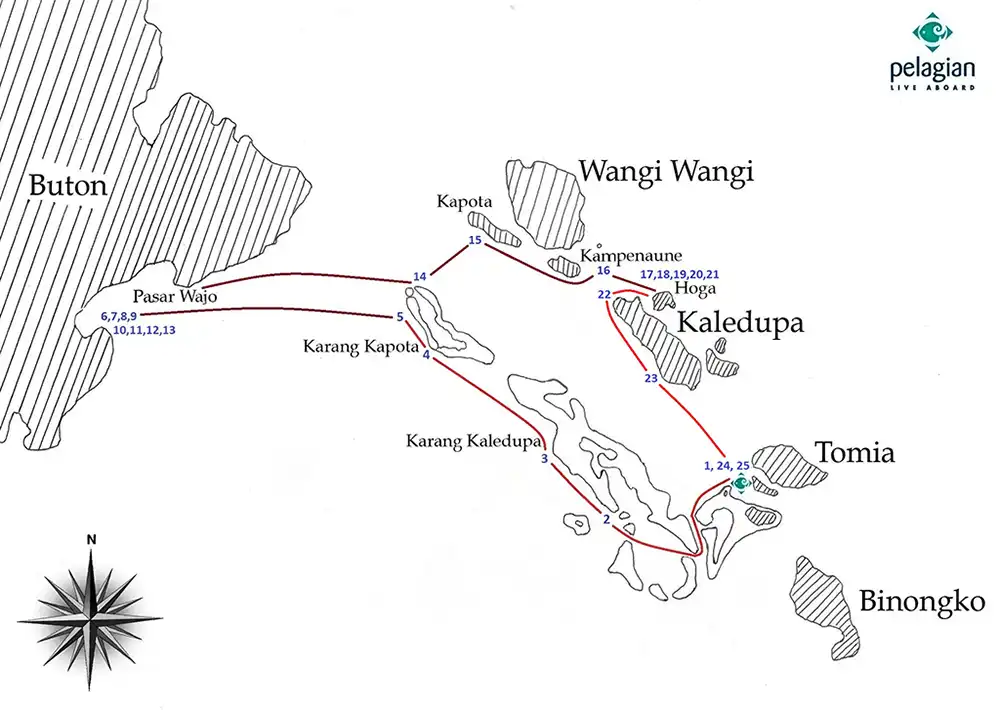
The first day of Pelagian’s seven-day itinerary (ten-day cruises can also be arranged) begins with a couple of afternoon warm-up dives close to the resort before heading further into the Wakatobi Regency’s National Park.
On the second day, divers get to explore sites on the large atolls of Karang Kaledupa and Karang Kapota, where the reefs feature steep slopes, walls and overhangs covered by a broad range of vibrantly coloured soft coral species, and large gorgonians in hues of red, orange, pink and yellow.
The atolls are home to large aquatic life such as blackfin barracuda, green sea turtles and eagle rays, and a wealth of smaller finds, including the tiny shrimp and gobies found on the often overlooked sea whips that cover the slopes and walls of many of Wakatobi’s dive sites.
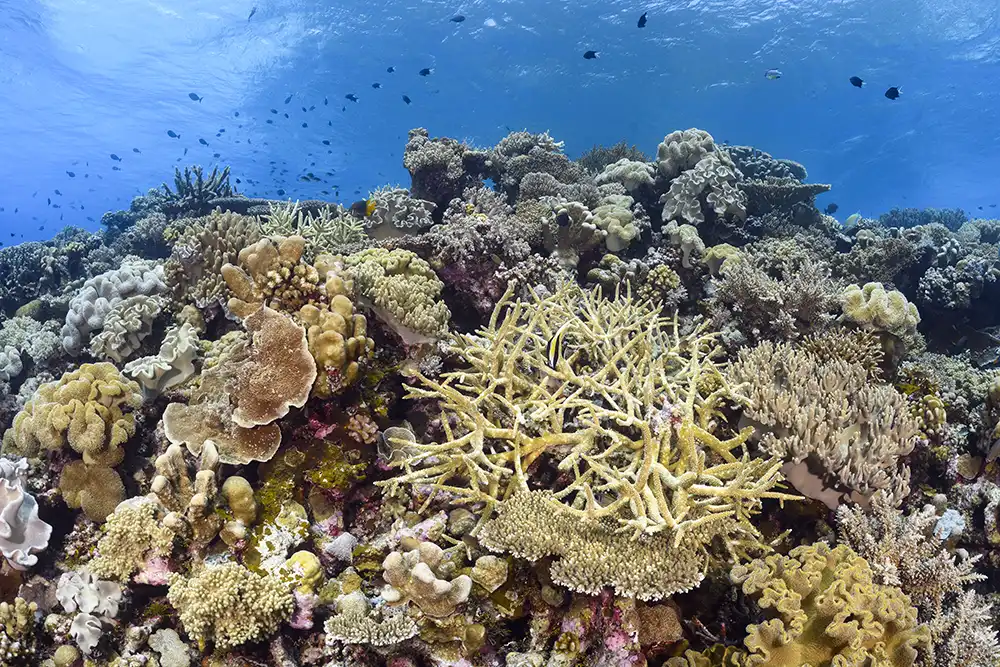
A highlight of any Pelagian cruise is the abundance of opportunities to find pygmy seahorses, as the area is home to three of the most well-known species: Bargibant’s pygmy sea horse (Hippocampus bargibanti), Denise’s pygmy sea horse (Hippocampus denise) and Pontoh’s, or weedy pygmy, sea horse (Hippocampus pontohi).
The dive guides are specialists in finding the tiny, white Pontoh’s sea horses that shelter in the Halimeda algae. Capturing these small creatures can be a challenging exercise in macro photography, but they make for great subjects whether viewed through the lens of a camera or an underwater magnifying glass.
Just as at the resort, Pelagian’s dive guides provide the best levels of in-water support while simultaneously being experts at locating rare marine subjects. There is also plenty of time to enjoy the dives, as many are relatively shallow and set against vertical reliefs, making it easy to perform up to four multi-level dives each day (the last of which may be a night diver) with bottom times of 70 minutes or more but no decompression required.
Playing in the muck
The wealth of marine diversity found on reefs within the Wakatobi Regency is exceptional, and no Pelagian cruise would be complete without a visit to the southeastern side of Buton Island and its muck diving.
Within the confined waters of Buton Island’s Pasar Wajo Bay lie a variety of environments from grey and brown silt and rubble to white sand bays with small coral gardens, with some of the best muck dives at sites such as Cheeky Beach, Banana Beach and In Between.
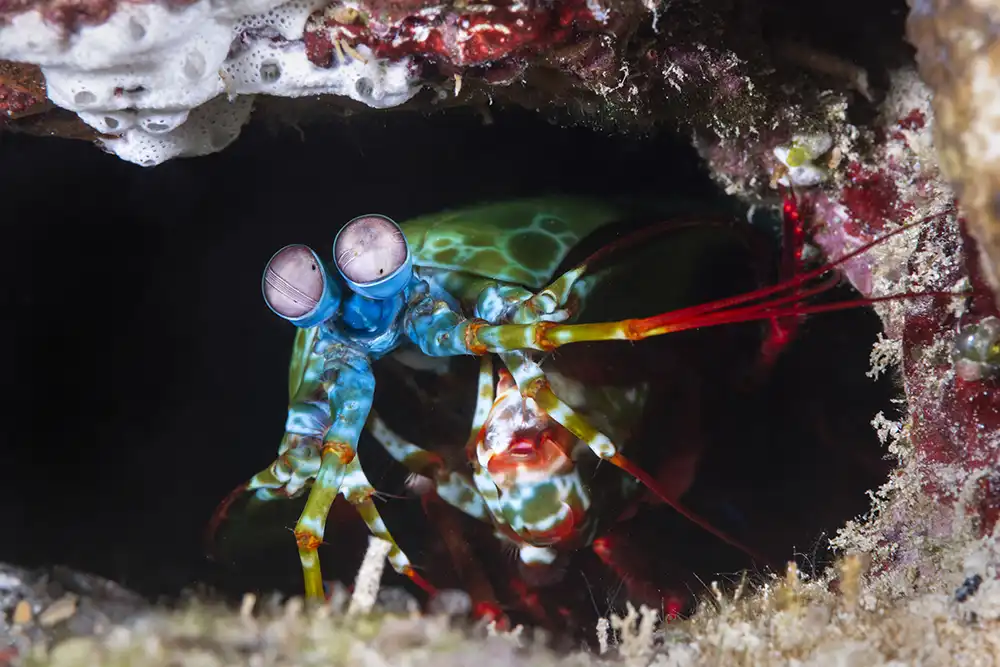
These sites feature gradual slopes from the shoreline down to 30m/100ft, with a desert-like bottom comprised mostly of sand and gravel. Unattractive as it might seem to the uninitiated, the muck holds a menagerie of marine life – from the alien-like peacock mantis shrimp and shrimp gobies keeping house with their symbiotic alpheid shrimp roommates (who seem to do all the work), to wonderpus, snake eels, or cryptic-looking zebra crabs hanging out on their fire anemones.
Pier diving
Any self-respecting muck diving destination should include a pier dive, and in Pasar Wajo Bay, Pelagian has three to sample: Asphalt Pier, New Pier and Magic Pier.
Each provides its own character and attractions, such as fan favourite Asphalt Pier, which – despite appearing to be abandoned – serves as the island’s primary terminal for loading bitumen quarried on the island onto waiting cargo vessels.
Divers can safely hunt around the front of the pier and among the clusters of pilings at depths between 5m/15ft and 14m/45 feet., where they will find shrimp gobies, frogfish, leaf scorpionfish and robust ghost and banded pipefish, plus many more.

As the name suggests, New Pier is the most recently constructed landing dock in Pasar Wajo Bay. With a similar depth profile to Asphalt Pier, the pilings are a great spot for finding blue ribbon eels, ringed pipefish and spiny devil scorpionfish, and the adjacent debris field a good place to hunt for octopus and gobies, which take refuge in shells, cans and bottles.
Saving the best for last is Magic Pier, best visited between dusk and dawn when the pier’s wildlife is most active. It is a prime site to spot a host of invertebrates from cuttlefish and blue-ringed octpuses, nudibranchs and flatworms, to finny oddities like frogfish and twin-spot lionfish.
But what truly what makes Magic Pier magical is that it is loaded with mandarinfish. When the sun starts to set, this garish member of the dragonet family emerges from hiding to mate allowing photographers and videographers to catch the sequence of courtship and spawning.
Back to reefs, walls and pinnacles
The third leg of Pelagian’s itinerary skirts the southwestern edges of Wangi Wangi and Kaledupa Islands, providing another round of magnificent reefs, dramatic vertical drop-offs and pinnacles.
A favourite among the broad list of sites around Wangi Wangi is Komang Reef, an elongated sea mound alive with growths of vibrant soft corals and sponges nurtured by the currents, and swarmed by plenitudes of fish life that peak when the tide changes.
Another divers’ favourite, Fishmarket – a combination of a steep wall with two deep ravines and a pinnacle rising to around 10m below the surface – is aptly named for the high numbers of schooling fish it attracts, including a huge school of blackfin barracuda.

On the way to and from its home base at Wakatobi Resort, Pelagian may stop at sites on the outer edge of day-boat range such as the seamounts of Blade. This unusual structure consists of a series of knife-edged pinnacles running in parallel, and connected by a lower ridge that gives the entire structure the appearance of a serrated knife blade set on edge.
These are just some of the many memorable sites that divers will experience on board Pelagian, and by combining a cruise with a stay at Wakatobi Resort, guests can experience the best scuba diving that Indonesia has to offer.
Contact the Wakatobi team at office@wakatobi.com for more information or to book a trip, and check out www.wakatobi.com for more information about Pelagian and the resort.


